Faced with a wet day in Los Angeles, I decided to pay a visit to the world renowned Petersen Automotive Museum, located in Museum Mile, on the Wilshire Boulevard, on the fringes of Beverly Hills. The museum is spread over 2 floors, and has a permanent set of exhibits, and plenty of space for a number of temporary displays. The permanent display comprises a number of street scenes from the earliest days of motoring, to the early 1960s, meandering around the ground floor. There are some very informative display panels which show how the greater Los Angeles area developed as a consequence of the motor car, and vice versa, making for a very interesting display. The first car made in the Los Angeles area was made, not surprisingly, in a blacksmith’s forge, from readily available parts, by one Mr Breer. However, the real birth of the American automobile was elsewhere in the nation, and one early success was Cadillac, an example of the 1903 Model A is on display.
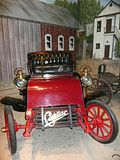 Early motorists in the Los Angeles area – and elsewhere – had it far from easy, with few roads, and cars that could not be relied on to go very far between breakdowns. One of the cameo scenes was a representation of a southern Californian road
Early motorists in the Los Angeles area – and elsewhere – had it far from easy, with few roads, and cars that could not be relied on to go very far between breakdowns. One of the cameo scenes was a representation of a southern Californian road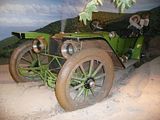 It did not take long before people started to figure out how to go faster than anyone else, and so motor racing was born. One of the most notable US names in this field was Stutz
It did not take long before people started to figure out how to go faster than anyone else, and so motor racing was born. One of the most notable US names in this field was Stutz It took a while before the “format” of the car as we know it now became standard, with all sorts of experiments in the early years. This was the Detroit Electric Carriage.
It took a while before the “format” of the car as we know it now became standard, with all sorts of experiments in the early years. This was the Detroit Electric Carriage.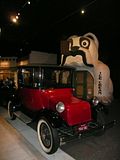
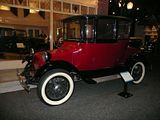 And this was the Franklin. In the background is an example of what the wonders of fibreglass and some creative imagination did to the roadside diner in the US in the 1950s.
And this was the Franklin. In the background is an example of what the wonders of fibreglass and some creative imagination did to the roadside diner in the US in the 1950s.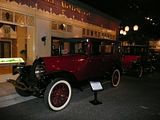 Slightly surprisingly, there was a 1929 Austin Seven in the museum, complete with right hand drive.
Slightly surprisingly, there was a 1929 Austin Seven in the museum, complete with right hand drive. The backgrounds and street scenes are just as impressive as the cars. A typical filling station from the 1930s was especially impressive.
The backgrounds and street scenes are just as impressive as the cars. A typical filling station from the 1930s was especially impressive.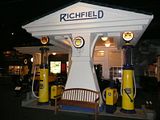
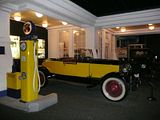
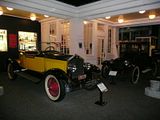 It was complemented by a whole row of petrol pump types from through the ages.
It was complemented by a whole row of petrol pump types from through the ages. Ford, of course, was responsible to a great extent for motorising America, and this Model A, from the early 1930s was an example of a car that sold in its millions.
Ford, of course, was responsible to a great extent for motorising America, and this Model A, from the early 1930s was an example of a car that sold in its millions.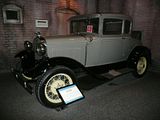 As the world started to get motorised, light commercial vehicles started to replace the bicycle, and this Delivery Van was typical of those in service from the 1930s.
As the world started to get motorised, light commercial vehicles started to replace the bicycle, and this Delivery Van was typical of those in service from the 1930s.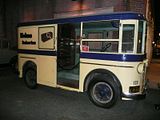 And this was a Ford Model BB.
And this was a Ford Model BB. 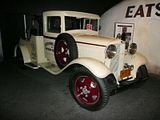 The late 30s were represented by a series of 4 cars parked outside a “grocers”.
The late 30s were represented by a series of 4 cars parked outside a “grocers”.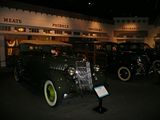 This 1940 Plymouth was representative of a typical family car of the time.
This 1940 Plymouth was representative of a typical family car of the time.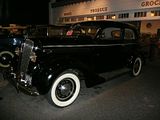 At the very top end of the market was the Duesenburg Model SJ. Although several hundred of these were made, it is believed that no 2 are alike
At the very top end of the market was the Duesenburg Model SJ. Although several hundred of these were made, it is believed that no 2 are alike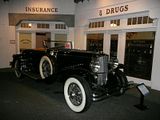 Another luxury marque from the 1930s was the Packhard, and here is a splendid tourer from that time.
Another luxury marque from the 1930s was the Packhard, and here is a splendid tourer from that time.
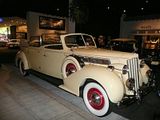 Two wonderful period pieces from the 1950s: a first generation Thunderbird, and a 1959 Cadillac de Ville, the car with the largest fins ever seen on a production car.
Two wonderful period pieces from the 1950s: a first generation Thunderbird, and a 1959 Cadillac de Ville, the car with the largest fins ever seen on a production car.

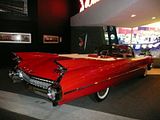
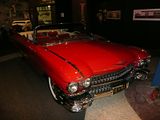 A final display is of a “typical” garage from the early 60s, housing 2 cars, and some neat wooden shelving with a few choice period memento’s hung up out of the way. One of the cars in this period reconstruction was a rather nice TR3.
A final display is of a “typical” garage from the early 60s, housing 2 cars, and some neat wooden shelving with a few choice period memento’s hung up out of the way. One of the cars in this period reconstruction was a rather nice TR3.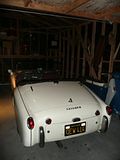 One of the displays upstairs is around alternative energy sources. Three recent examples are clustered together, from GM, Honda and Nissan. The Nissan Hypermini went on sale in Tokyo in 2001.
One of the displays upstairs is around alternative energy sources. Three recent examples are clustered together, from GM, Honda and Nissan. The Nissan Hypermini went on sale in Tokyo in 2001.
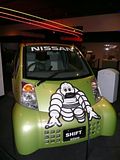
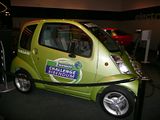 The Honda EV dates from 1989, and was the first hybrid vehicle, predating the Prius by some years. The cars cost $53,000, which was a lot of money, so almost all of them were leased. Honda then managed to recall them at the end of the leases, and scrapped most of them.
The Honda EV dates from 1989, and was the first hybrid vehicle, predating the Prius by some years. The cars cost $53,000, which was a lot of money, so almost all of them were leased. Honda then managed to recall them at the end of the leases, and scrapped most of them.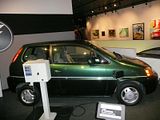 GM launched their EV1 in the early 1990s, and also placed these in the hands of carefully selected customers in California, under 3 or 4 year leases. When the leases ran out, GM recalled the cars, and despite desperate attempts from the very enthusiastic owners to buy them, GM refused, and crushed all bar a handful of cars which are now in museums.
GM launched their EV1 in the early 1990s, and also placed these in the hands of carefully selected customers in California, under 3 or 4 year leases. When the leases ran out, GM recalled the cars, and despite desperate attempts from the very enthusiastic owners to buy them, GM refused, and crushed all bar a handful of cars which are now in museums.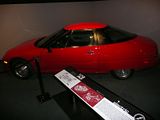 An earlier attempt – also leading to failure and cars being crushed, was to go down the gas turbine route. This was Chrysler’s effort in 1965. In the background is a Fuel Cell vehicle based on the 2001 Nissan X-Terra.
An earlier attempt – also leading to failure and cars being crushed, was to go down the gas turbine route. This was Chrysler’s effort in 1965. In the background is a Fuel Cell vehicle based on the 2001 Nissan X-Terra.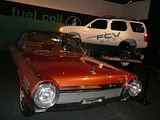 A separate display, trading on the fact that Los Angeles is still the movie and celebrity capital of the world, contains some famous vehicles once owned by movie stars and celebrities. This very rare Jaguar XKSS was originally owned by Steve McQueen.
A separate display, trading on the fact that Los Angeles is still the movie and celebrity capital of the world, contains some famous vehicles once owned by movie stars and celebrities. This very rare Jaguar XKSS was originally owned by Steve McQueen.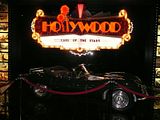
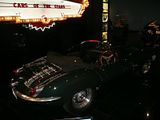 In addition a number of vehicles that have actually starred in movies themselves are included. Here are some of the notable ones: The Batmobile, from the 1999 remake.
In addition a number of vehicles that have actually starred in movies themselves are included. Here are some of the notable ones: The Batmobile, from the 1999 remake.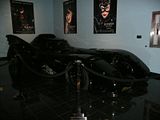 And the Batbike from the 1967 original.
And the Batbike from the 1967 original.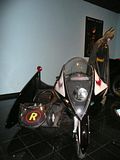 Green Hornet, from the 1968 Black Beauty
Green Hornet, from the 1968 Black Beauty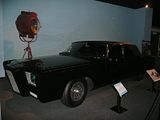 A couple of Herbie’s………… from the recent films, not the originals.
A couple of Herbie’s………… from the recent films, not the originals.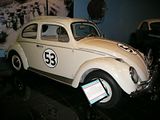
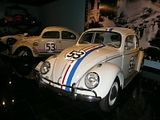 And two stars from “Cars”, made in 2006:
And two stars from “Cars”, made in 2006: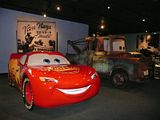 Savour the pairing of an original Ford GT40 with the much more recent Ford GT, as depicted here:
Savour the pairing of an original Ford GT40 with the much more recent Ford GT, as depicted here: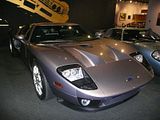
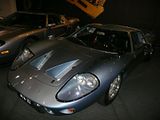 There was a special display of Microcars – quite a surprise to find this in an American car museum, as hardly any of these cars were ever sold in the US market. However, it would seem that a good number of them are now to be found in various collections across the 50 states now. It is reckoned that a surprising number of these oddities have survived, not least because they were so small, that rather than take them to a scrap yard, many of their owners simply abandoned them in fields, hedgerows, barns etc. One of the earliest cars on display was actually imported to the US. This was the first Morgan imported into America, in 1927. Although it sports a rather odd-looking cover over the engine, there are enough clues to be able to see the more traditional appearance of the V engine layout, and the fact that this is indeed a three wheeler.
There was a special display of Microcars – quite a surprise to find this in an American car museum, as hardly any of these cars were ever sold in the US market. However, it would seem that a good number of them are now to be found in various collections across the 50 states now. It is reckoned that a surprising number of these oddities have survived, not least because they were so small, that rather than take them to a scrap yard, many of their owners simply abandoned them in fields, hedgerows, barns etc. One of the earliest cars on display was actually imported to the US. This was the first Morgan imported into America, in 1927. Although it sports a rather odd-looking cover over the engine, there are enough clues to be able to see the more traditional appearance of the V engine layout, and the fact that this is indeed a three wheeler.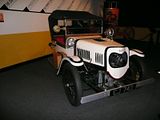 All sorts of odd vehicles form names you and I have never heard of were on display, and here are some of the real oddities. A 1945 Rolux Baby Model VB-60 – this was a French effort
All sorts of odd vehicles form names you and I have never heard of were on display, and here are some of the real oddities. A 1945 Rolux Baby Model VB-60 – this was a French effort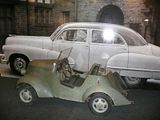 A 1951 Skorpion. German, this one.
A 1951 Skorpion. German, this one.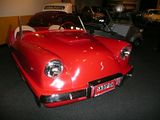 Another German effort was this 1955 Kleinschnittger F-125
Another German effort was this 1955 Kleinschnittger F-125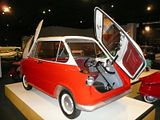 A couple more:
A couple more: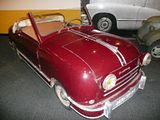
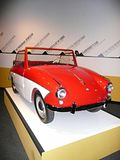


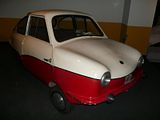 The real boom time for microcars was in the 1950s, when people had a little more money, and wanted a means of transport that would protect them from the elements as they and perhaps some of their family made short journeys to do the shopping and for social occasions. Low purchase costs were further helped by low running costs (important especially after the 1956 Suez crisis) and favourable reduced tax liabilities, and many firms appeared in the 50s, thrived for a little while, then in most cases, disappeared again. One country who produced some of the better known models was Germany, of course. And among the most famous is the Messerschmitt. Two examples of the Kabinenroller (literally, the “Cabin Scooter”) were on show, one of which is a very rare convertible model. Most of these cars were produced with a plexiglass roof. Top speed, for the brave was over 60 mph – not bad for 200cc. The later Tiger models, with a 493cc engine were good for over 80 mph.
The real boom time for microcars was in the 1950s, when people had a little more money, and wanted a means of transport that would protect them from the elements as they and perhaps some of their family made short journeys to do the shopping and for social occasions. Low purchase costs were further helped by low running costs (important especially after the 1956 Suez crisis) and favourable reduced tax liabilities, and many firms appeared in the 50s, thrived for a little while, then in most cases, disappeared again. One country who produced some of the better known models was Germany, of course. And among the most famous is the Messerschmitt. Two examples of the Kabinenroller (literally, the “Cabin Scooter”) were on show, one of which is a very rare convertible model. Most of these cars were produced with a plexiglass roof. Top speed, for the brave was over 60 mph – not bad for 200cc. The later Tiger models, with a 493cc engine were good for over 80 mph.

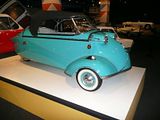 Another manufacturer who came to prominence at this time was BMW, who take a licence from Iso to produce the Isetta. BMW changed the car by adding their own engine, and gradually introduced a number of their own innovations.
Another manufacturer who came to prominence at this time was BMW, who take a licence from Iso to produce the Isetta. BMW changed the car by adding their own engine, and gradually introduced a number of their own innovations.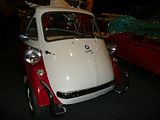 In Nuernberg, Zundapp came up with this one, the Janus, dating from 1958. Named after the Roman God of doors and gateways, the entry doors at front and back, meant it almost looked the same in either direction
In Nuernberg, Zundapp came up with this one, the Janus, dating from 1958. Named after the Roman God of doors and gateways, the entry doors at front and back, meant it almost looked the same in either direction Meanwhile, in what was then Czechoslovakia, a rather different approach was taken, with the long-lived Velorex. The bodywork was made from a sort of reinforced canvas, and was detachable, to help you to clean it. First produced in the early 1950s, the display model was actually made in 1967.
Meanwhile, in what was then Czechoslovakia, a rather different approach was taken, with the long-lived Velorex. The bodywork was made from a sort of reinforced canvas, and was detachable, to help you to clean it. First produced in the early 1950s, the display model was actually made in 1967.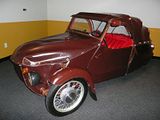 Many of the first Japanese cars, made to their own design, were micro-cars. Mazda, for instance, made their first car, the R-360, so called because it had a 360cc engine, in the very early 1960s.
Many of the first Japanese cars, made to their own design, were micro-cars. Mazda, for instance, made their first car, the R-360, so called because it had a 360cc engine, in the very early 1960s.
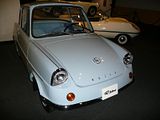 Subaru had a 360 model, too. Malcolm Bricklin first imported these into the US in 1968, and tried for two years to sell them, but found very few takers. It was only when Subaru were making rather larger cars, in the mid 70s that they started to sell in America.
Subaru had a 360 model, too. Malcolm Bricklin first imported these into the US in 1968, and tried for two years to sell them, but found very few takers. It was only when Subaru were making rather larger cars, in the mid 70s that they started to sell in America.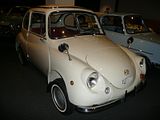
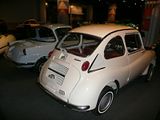 Honda also started car manufacture at this end of the market. The N Series cars started with a 360cc engined model, too, but gradually Honda enlarged the engines to create the N600, and this model dates from 1965.
Honda also started car manufacture at this end of the market. The N Series cars started with a 360cc engined model, too, but gradually Honda enlarged the engines to create the N600, and this model dates from 1965.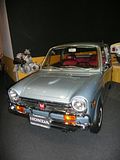 Their next venture was a small sports car – the S600. Although these were never officially imported to the US, a surprising number of them have been imported, and this example was even a left hand drive version.
Their next venture was a small sports car – the S600. Although these were never officially imported to the US, a surprising number of them have been imported, and this example was even a left hand drive version.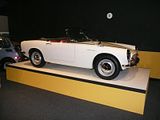
 The Russians had a go, too. However, their first efforts, which were based on Fiat 500s soon changed to their own design, based clearly on the NSU Prinz-style of “bathtub” styling, with the ZAZ Zaphrozhets.
The Russians had a go, too. However, their first efforts, which were based on Fiat 500s soon changed to their own design, based clearly on the NSU Prinz-style of “bathtub” styling, with the ZAZ Zaphrozhets.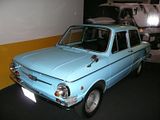
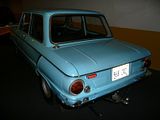 It was the launch of the Mini in 1959 that really marked the end for most microcars, but designers have continued to return to the theme ever since. Ford had a go in 1983, with this Ghia Trio Concept Car, a 3 seater, where the driver sits in the middle of the car, alongside the passengers’ legs, McLaren F1-style.
It was the launch of the Mini in 1959 that really marked the end for most microcars, but designers have continued to return to the theme ever since. Ford had a go in 1983, with this Ghia Trio Concept Car, a 3 seater, where the driver sits in the middle of the car, alongside the passengers’ legs, McLaren F1-style.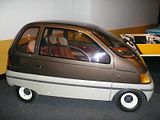 Most recently, of course, it is smart who have made a real success with this format, and a first generation forTwo was on display. Smarts are going on sale in the US in 2008. It will be interesting to see how they do.
Most recently, of course, it is smart who have made a real success with this format, and a first generation forTwo was on display. Smarts are going on sale in the US in 2008. It will be interesting to see how they do.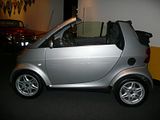 I have left my favourites until last: Fiat. The ubiquitous 500 was of course represented in the exhibition.
I have left my favourites until last: Fiat. The ubiquitous 500 was of course represented in the exhibition.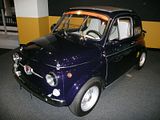 Also on show was a Ghia Jolly. When new, these cost roughly twice as much as the 500 that they were based on, so most of the first owners were wealthy, and the Jolly quickly became a very fashionable item.
Also on show was a Ghia Jolly. When new, these cost roughly twice as much as the 500 that they were based on, so most of the first owners were wealthy, and the Jolly quickly became a very fashionable item. 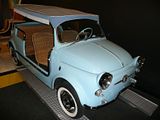 Nicest car of all, in my opinion, was this Multipla. Dating from 1957, based on the hugely successful Fiat 600, this was effectively an early people carrier, seating 6 people, in a very small footprint.
Nicest car of all, in my opinion, was this Multipla. Dating from 1957, based on the hugely successful Fiat 600, this was effectively an early people carrier, seating 6 people, in a very small footprint.
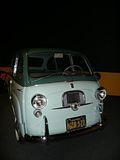
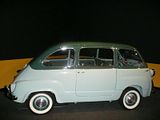 Back outside the museum, there are a few vehicles in the associated car park. A Mack AC truck, nicknamed “the Bulldog”:
Back outside the museum, there are a few vehicles in the associated car park. A Mack AC truck, nicknamed “the Bulldog”: A Ford Model BB Truck
A Ford Model BB Truck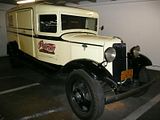 Green Thunder – world land speed record holder in 1965 (not for long).
Green Thunder – world land speed record holder in 1965 (not for long).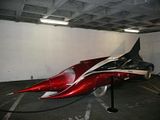 Also in the car park, I spotted a couple of other interesting vehicles: Lotus Eclat – still with a UK front licence plate. The rear was an Arizona plate (no front plates are needed in AZ):
Also in the car park, I spotted a couple of other interesting vehicles: Lotus Eclat – still with a UK front licence plate. The rear was an Arizona plate (no front plates are needed in AZ):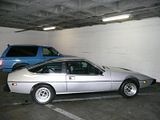 And a Subaru SVX – definitely a classic in the making, if it is not already.
And a Subaru SVX – definitely a classic in the making, if it is not already.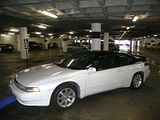 More details on the museum can be found at http://www.petersen.org
More details on the museum can be found at http://www.petersen.org2009-12-18 15:15:40















































































